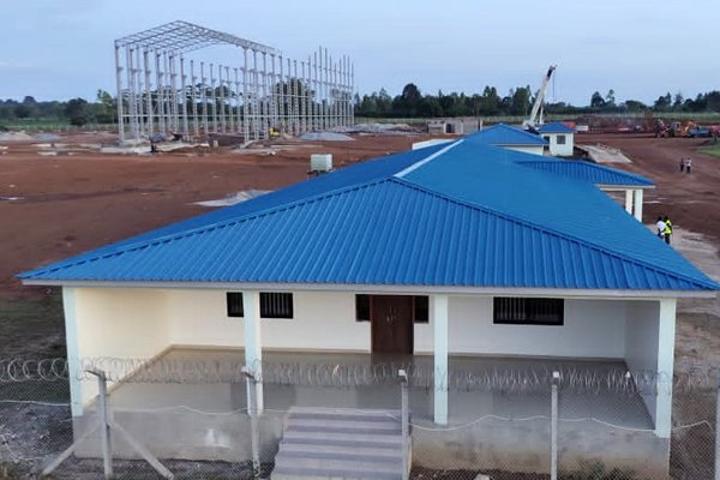Africa-Press – Uganda. A long line of old trucks crammed with sugarcane is what welcomes you at GM Sugar Uganda Limited in Njeru Municipality, Buikwe District, on the Kampala- Jinja Highway as you exit Buganda region for Busoga sub-region. Once you are in the eastern part of the country, an even bigger file of trucks loaded with sugarcane is found along Musita-Mayuge-Lumino-Majanji-Busia road where they supply Mayuge Sugar Industries (MSIL).
The sugarcane on these trucks is the produce of outgrowers, who mainly come from the Busoga sub-region. Trucks spend here days as suppliers try to sell off the sugarcane and if they fail to reach an agreement with the would-be buyers, they move on to other millers hence an increase in transport costs.
Since the 1920s, farmers in Busoga Sub-region and surrounding areas have for various reasons made sugarcane growing their main economic activity, with the sub-region now having an estimated 20,000 outgrowers, who feed about six millers; MSIL, Kamuli Sugar Limited, Kaliro Sugar Limited, Kakira Sugar, Sugar Corporation of Uganda Ltd (Scoul) and GM. Four of the sugar millers are located in Busoga Sub-region. They include MSIL, Kamuli Sugar and GM Sugar Uganda Ltd that are owned by Mr Magan Patel, the proprietor of Nile Agro Industries Ltd. The other is Kakira Sugar owned by Madhvani Group. Busoga outgrowers also supply Scoul, which is owned by Mehta Group.
With Kakira getting a huge chunk of its sugarcane from its own vast plantation, outgrowers in most cases are left with limited options thus gaining little from their hard labour or in the worst-case scenario, they are left counting losses. “That means we as outgrowers, we do not have serious alternatives,” Mr Godfrey Naitema, the spokesperson of Busoga Sugarcane Outgrowers Association, says.“If Magan and Madhvani are offering low prices, then that is it. You have few viable options.” For years now, there has been a split of opinion on how best the sugar industry, more so in Busoga Sub-region, should be conducted, with tempers sometimes flaring. The big milling companies have insisted there should be restrictions on the number of millers if the quality of sugar is to be maintained and if the environment is to be protected. Perhaps acting at the behest of the big players in the industry, in 2013, President Museveni instructed Trade minister Amelia Kyambadde to close new sugar factories within a radius of less than 25km from the existing ones, as well as those that had disregarded their obligation to guarantee food security while carrying out their activities.
In 2017, the government threatened to relocate GM and MSIL to other areas on grounds that they wanted to curtail sugarcane growing, which it claimed had caused famine, poverty and environmental degradation in Busoga. “Some of the factories will close because of this new policy and the remaining ones will be given money to relocate to other area, as well as a tax holiday of five years without paying corporate tax until they stabilise,” Mr Moses Kizige, the Minister of State for Karamoja Affairs, said back then. All of these plans, however, were upended when last year, Mr Museveni penned into law the Sugar Bill without the zones he had earlier advocated, much to the disappointment of big millers.
Workers go about their duty at the Bugiri Sugar Works factory in Bugubo Village, Kapyanga Sub-county, Bugiri District, recently. PHOTO/TAUSI NAKATO
“We wanted to zone so that farmers work with a particular company to know what cane they harvest in a season and how it can be consumed … now that was not considered,” Mr Jim Kabeho, a manager at Kakira Sugar Ltd, who doubles as the chairperson of Uganda Sugar Manufacturers Association, said last year, insisting that the law failed to foster cooperation between growers and millers. “You will have no farmer committed to a company and a company to farmers,” he added.
That said, outgrowers in Busoga predictably have had a different take – they think having many millers in the sub-region is a good thing as it unleashes all the benefits of a free-market economy such as competition for the sugarcane, a commodity they say they have in plenty. “The millers we have right now cannot exhaust what we have and if you recall, this is what we told the President and he thought we were lying until he came down here and he came to the same conclusion. We have a lot of cane and the big factories want to take advantage of us. The more millers, the better for us as outgrowers. There is no doubt about that. I speak for all out-growers in Busoga,” Mr Naitema says.
Mr Ramathan Ggoobi, a policy analyst and lecturer at Makerere Business School, agrees with outgrowers that for a long time, they have been cheated by millers. “It is only in Uganda where one player dominates the whole chain of production. One player who plants sugarcane, processes it, transports it, wholesales and also owns retail. That should be stopped,” he says. He adds: “Many of these outgrowers have their own farms so they just do not take outgrowers seriously.”
Enter Bugiri Sugar Works
Mr Naitema’s prayers for more millers in Busoga are being answered in Bugubo Village, Kapyanga Sub-county, Bugiri District, where they have never had a miller, before. In April last year, as the country was still grappling with the Covid-19-induced lockdown, tractors and excavators made their way to a 60-acre piece of land in the quiet village of Bugubo. They started turning Bugiri Sugar Works Limited into a reality by setting up structures one after the other.The business model of Bugiri Sugar Works, which is slated to produce bags of sugar by December, is music to the ears of outgrowers.
“For the start, we shall be producing 4,800 bags of sugar per day, and we are going to be buying from outgrowers mainly. This area has a lot of outgrowers who just need market and we are going to fill that void,” Mr Yash Patel, a director of the company, explains. For the outgrowers in Bugiri and surrounding areas, the idea that this sugar milling company is going to be buying from them could mean a lot.They are currently incurring high costs in transporting sugarcane to Mayuge, Kaliro, Kamuli, Jinja or even the far-flung Atiak sugar factory in the northern district of Amuru.
Farmers harvest sugarcane at a plantation in Jinja District on April 23, 2019. Sugarcane growing is the main economic activity of many people in Busaga Sub-region. PHOTO/TAUSI NAKATO
“To transport sugarcane, besides hiring a truck, one needs to pay Shs50, 000 for the permit,” explains Mr Hassan Bwire, a resident of Bugubo Village, who is currently working as a supervisor at the Bugiri Sugar Works construction site. “So it means the costs of going to those far away districts is quite high. Farmers, therefore, sell to middlemen, who eventually make more money when they sell to the millers. I think this will change once Bugiri Sugar starts operation,” he adds.
In a crowd of millers, Bugiri Sugar wants to stand out by bringing something different. “We shall be concentrating on industrial sugar. Sugar is used in beverages and beers. No milling company here produces industrial sugar. We shall be the first,” Mr Patel reveals. “After sugar production, we shall invest in ethanol production.” Sugarcane ethanol is a synthetic alcohol-based fuel produced by fermentation of sugarcane juice and molasses. Since it is a clean, affordable and low-carbon biofuel, sugarcane ethanol has emerged as a leading renewable fuel for the transportation sector worldwide.Before the excavators made their way to Bugubo, the area was not connected to the national grid, but this is no longer the case as the sugar factory has enabled the villagers here to get power after securing a transformer.
“Electricity alone can change an area,” Mr Umar Mulawa, a district councillor, says. “We already see change with this electricity. You know businesses cannot do well without electricity. So we expect more, but this is a good start.”Mr Patel is well aware of the expectations, and he says in their plans, they envisage the milling plant will be used as the springboard to turn around the fortunes of the village. “This will soon be a business centre with hotels, hostels, education centres and much more,” he says. “It is just a matter of time.”Bunyoro Sub-region
The need to break down monopoly in the sugar industry goes beyond Busoga. In Bunyoro Sub-region, there are three millers: Kinyara Sugar Works Limited, Hoima Sugar Limited and Kiryandogo Sugar Limited, but they are owned by the Rai Group domiciled in Mauritius. However, out-growers in Bunyoro are not happy with how the group deals with them. “In Hoima, we have only one investor – Ria. He secured a licence in Kako, Kinyara, Hoima and Kikuube. He secured a licence in Kirayandongo. So there is no competition. He dominates and determines the price and that is why in this region, sugarcane prices are lowest compared to the whole country,” Mr Cosmas Byaruhanga, the Masindi District chairperson and a leading out-grower, says. Mr Byaruhanga also prides himself in fighting sections of the Sugar Bill that intended to introduce zoning, saying he was vindicated when Mr Museveni ultimately agreed that zoning was not a good policy. “Even in Busoga Sub-region where they have many factories, they ended up having sugarcane flooding. Now supposing they were zoning? Today, Busoga is selling sugarcane to Atiak – an arrangement that was originally secured by Masindi but then taken over by Busoga because of a bigger political voice. So they took it yet Masindi, which is near Atiak, we are suffering,” Mr Byaruhanga who, is also the out-going Bunyoro Outgrowers chairperson, says.
“We have lost a lot of sugarcane because we have no buyers. Kenya is no longer taking our sugarcane in time. They are harvesting their own sugarcane because they have their own big plantation and it is expanding. Our policy in Uganda does not favour farmers yet we say we are an agricultural country. You cannot allow an investor to come into the country and start growing sugarcane as if you do not have farmers who do that.”
PolicyZoning
In 2017, the government threatened to relocate GM and MSIL to other areas on grounds that they wanted to curtail sugarcane growing, which it claimed had caused famine, poverty and environmental degradation in Busoga. The plan was, however, upended when last year, Mr Museveni penned into law the Sugar Bill without the zones he had earlier advocated, much to the disappointment of big millers.
Sugar caneBusoga
Since the 1920s, farmers in Busoga Sub-region and surrounding areas have for various reasons made sugarcane growing their main economic activity, with the sub-region now having an estimated 20,000 outgrowers, who feed about five millers: MSIL, Kamuli Sugar Limited, Kaliro Sugar Limited, Kakira Sugar and GM and Scoul.






